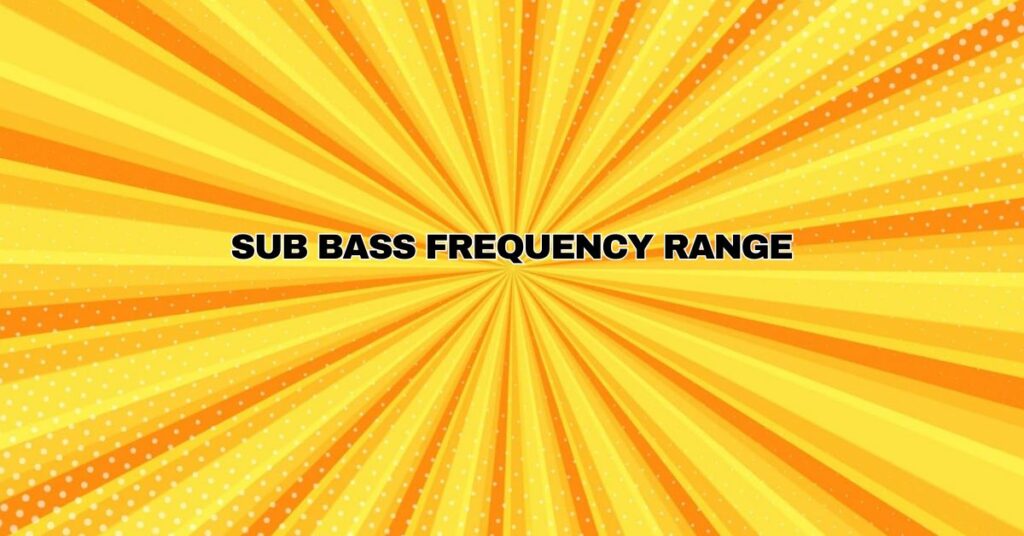In the realm of music and audio production, the sub bass frequency range stands as a cornerstone of sonic artistry. Sub bass frequencies are the foundation of the low-end spectrum, responsible for delivering the deep, resonant, and often visceral sensations that shape the essence of music and audio. In this comprehensive article, we will explore the profound world of sub bass frequency range, understanding its definition, importance, and applications in various musical genres and audio systems.
Defining the Sub Bass Frequency Range
Sub bass frequencies encompass the lowest, most profound tones in the audible sound spectrum. These frequencies are characterized by their substantial power and impact, often felt as physical vibrations and atmospheric rumbles. The sub bass frequency range typically covers the region below 60 Hertz (Hz), making it distinct from other bass frequencies. Within the sub bass range, the following subcategories are recognized:
- Sub-Bass (20-60 Hz): This category serves as the threshold of sub bass frequencies. Sub-bass frequencies begin at 20 Hz, offering the deep and foundational elements of audio. These frequencies set the stage for powerful and immersive listening experiences, both audibly and tactilely.
- Super Sub-Bass (Below 20 Hz): Frequencies below the 20 Hz mark are often referred to as super sub-bass or infrasound. Although these frequencies are typically beyond the threshold of human hearing, they can still be felt, adding to the overall physical impact of audio, particularly in large sound systems and subwoofers.
- Deep Sub-Bass (Below 10 Hz): Frequencies that extend below 10 Hz are commonly acknowledged as deep sub-bass. These are situated at the extreme low end of the audio spectrum, generating profound vibrations that border on tactile sensations more than audible sound.
The Significance of Sub Bass Frequency Range
The sub bass frequency range plays a crucial role in shaping music and audio experiences. Its significance can be explored through various lenses:
- Emotional Impact: Sub bass frequencies have the ability to evoke powerful emotions and enhance the mood of music. The deep, resonant tones are often employed to create a sense of grandeur, drama, or suspense.
- Immersive Soundscapes: Sub bass is pivotal in crafting immersive soundscapes in various audio applications, including movie soundtracks and video game sound design, providing depth and realism to the auditory experience.
- Physical Sensations: The tactile qualities of sub bass frequencies can create a unique physical experience, whether it’s the vibrating floor at a concert or the rumbling sensation in a thrilling movie scene.
- Rhythm and Groove: In genres like EDM, dubstep, and hip-hop, sub bass frequencies contribute to the rhythm and groove of the music. The pulsating and energetic quality they bring is integral to these genres’ appeal.
Applications Across Music Genres
The sub bass frequency range is widely utilized across a spectrum of music genres, each of which harnesses its power to different degrees:
- Electronic Dance Music (EDM): EDM genres, including trance, house, and drum and bass, prominently feature sub bass frequencies in the 30-60 Hz range. These frequencies are the driving force behind the thumping, pulsating basslines that define the genre.
- Hip-Hop and Rap: Hip-hop and rap music employ sub bass frequencies in the 30-40 Hz range and below to create deep, resonant basslines. These sub bass elements give tracks a punchy and impactful quality.
- Rock and Metal: While rock and metal may not be as sub-bass-heavy as electronic genres, they still benefit from sub bass frequencies in the 40-80 Hz range, adding depth and power to their sound.
- Classical Music: Even classical music may incorporate sub bass frequencies to enhance the depth of orchestral compositions, usually falling within the 30-60 Hz range.
Advanced Technologies for Sub Bass Reproduction
Reproducing sub bass frequencies effectively and accurately necessitates advanced audio technologies:
- Subwoofers: Specialized subwoofer speakers are designed to reproduce low-frequency sounds with precision. Available in various sizes and power ratings, they are crucial for handling sub bass frequencies effectively.
- Bass Management Systems: These systems, used in home theaters and professional audio setups, are essential for routing low-frequency content to subwoofers and maintaining an even audio spectrum.
- Amplifiers: High-quality amplifiers are critical for driving subwoofers and ensuring that sub bass frequencies are delivered with clarity and power.
- Room Calibration: Advanced audio systems often include room calibration technologies that analyze room acoustics and adjust sub bass frequencies to mitigate standing waves and resonances, ensuring a balanced sound.
Conclusion
The sub bass frequency range is a fundamental component of music and audio, adding depth, emotion, and physicality to the listening experience. Its influence can be felt across an array of musical genres and soundscapes, making it a critical element in the audio production process. Understanding the profound world of sub bass and its intricate nuances is essential for both audiophiles and music professionals, as it forms the bedrock of captivating, immersive, and powerful auditory experiences. Whether you’re a music enthusiast or an audio engineer, the sub bass frequency range is a rich territory to explore, shaping the emotional and visceral dimensions of sound.


